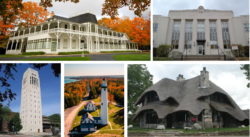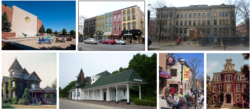


Have you made your summer travel plans yet? This month we continue our series of identifying some of the major festivals being held in the coming month and then explore some of the unique Michigan architectural buildings and historical areas near each specific festival, that reinforce MAF’s mission of “Advancing awareness of how architecture enriches life.” If you are planning a trip around Michigan this summer, please consider some of the following festival and tour options to learn more about Michigan Architecture:

Blue Water Festival, July 12-15, Downtown Port Huron: The Blue Water Fest – Port Huron’s Premier Summer Event!
Embark on an exhilarating journey as you immerse yourself in the captivating world of the “Blue Water Fest: Port Huron’s Boat Weekend.” Prepare for an extraordinary four-day extravaganza packed with non-stop entertainment and activities that will leave you with cherished memories, all while celebrating the vibrant maritime culture of Port Huron. The Festival features concerts, fireworks, OT’s Family Night, and Mannequins Making a Difference, all being kicked off by the Rotary International Day Parade. The last day of the Festival also marks the start of the 2023 Bayview Mackinac Race. Bayview Mackinac Race – The World’s Longest Continuously Run Long Distance Freshwater yacht Race (bycmack.com)
McMorran Place:
Named for the business and political leader whose family donated the money to build it, McMorran Place has longed served as a community anchor for Port Huron. Designed by Alden B. Dow and built in 1960, this clean and mostly unadorned exterior with an orderly progression of spaces on the inside. The limestone wall facing Huron Avenue features the Sculptor Marshall M. Fredericks designed figures dubbed Night and Day.
Fort Gratiot Lighthouse:
In 1823 Congress approved the funds to build the first lighthouse in Michigan and the second oldest on the Great Lakes. Originally sixty-five feet high, the white painted brick tower was extended to its present height of eighty-two feet in the early 1860s. Today, a Coast Guard station and the lighthouse watch over one of the busiest waterways in the world. Weather permitting, the Fort Gratiot Light Station is one of the few operating lighthouses that allow visitors to climb the tower and step out onto the catwalk for a breathtaking view. From the gallery, visitors can view the Blue Water Bridge, the mouth of the St. Clair River, Point Edward, Ontario and Lake Huron to the north.
Ladies of the Maccabees Building:
The Knights of the Maccabees, a fraternal organization, was organized in 1878, and re-organized in 1881 as the “Knights of the Modern Maccabees”. The Ladies of the Modern Maccabees were organized in 1886 as an auxiliary of the organization. The Ladies of the Modern Maccabees grew over the next decade, and severed ties with the men’s organization in 1902. In 1906, the organization hired architect George H. Harvey to design this building for use as their headquarters. The building was designed in the Classical Revival style with a rusticated foundation, smooth limestone walls, and a low-pitched roof with a shallow dome atop.
Carnegie Center Museum:
Originally the public library constructed in 1902 by Andrew Carnegie, is now home to the museum’s local history collections including the largest ship model collection and Black History in the Blue Water Area. Visit the reimagined projects including restoring the original glass mezzanine floor. Be sure to see the 1850’s Kammer Cabin on the museum grounds when visiting.
Charlevoix Venetian Festival, July 15-23: Venetian Festival – Visit Charlevoix, Michigan
Established in 1931, this jubilant tradition started with a simple candle-lit boat parade. Today, it is an 8-day festival that highlights big-name concerts, fireworks, a carnival, street and boat parades, athletic events, beachfront activities, street vendors, buskers and much more. The goal of the festival is to build community and connection, create lasting memories and bring people together. That is why you will not pay for a concert ticket or need a special pass. Everyone is invited and encouraged to participate, whether as a guest, a volunteer or a sponsor!
Dwarf or Mushroom Houses:
Also known locally as “Hansel and Gretel” homes, these extremely picturesque houses were designed to appeal to the romantic at heart. Earl A. Young, a self-trained real estate developer, crafted these fairy-tale dwellings out of boulders left behind by glaciers, timber from shipwrecks, local limestone, and whatever else struck his fancy. Over a span of 50 years, Young brought back ideas from his visits to English cottages and built from memory without any formal plans. Some of the houses are only 800 square feet and sized for Young’s 5’-4” height. For more information, see the Must-See-Michigan Architecture article in this month’s Newsletter.
Chicago Club:
Flag-bedecked and brilliant in the summer sunlight, the Chicago Club captures the easy charm of a northern Michigan resort. Built as a summer getaway by members of a Chicago church group, the clubhouse still sports its wrap-around verandas and its stick-style ornamentation. Simple yet elegant, catering to successive generations of families, this is the sort of place where you catch up with old friends and enjoy a community meal in the evening in the large dining room.
Chicago and West Michigan Railroad Charlevoix Station:
Built in 1892, this station served rail passengers until 1962. The building is a single-story rectangular, Shingle Style building with a hip roof. Covered platforms extend from the main mass at each end, giving the station a broad and low form. The exterior is clad with shingles below the windowsill level and clapboards above. The station has been renovated, and is currently owned by the Charlevoix Historical Society.
Charlevoix South Pier Light Station:
The first light in Charlevoix, built in 1884, was located on the north pier. This light was replaced in 1948 with the current steel structure, which was located on the south pier. The lens and lantern from the old structure were transferred to the new one. This light station is an extremely popular spot for both professional and amateur photographers looking for that classically beautiful Michigan sunset across the lake.
Ann Arbor Art Fair, July 20-22: Ann Arbor Art Fair (theannarborartfair.com)
The Ann Arbor Art Fair is a Midwest tradition that draws close to half a million attendees over three days in July. The largest juried art fair in the nation, the Ann Arbor Art Fair features nearly 1,000 artists and a footprint spanning 30 city blocks in downtown Ann Arbor. The Ann Arbor Art Fair is comprised of three independently juried, nonprofit art fairs that run concurrently: Ann Arbor Street Art Fair, The Original; Ann Arbor Summer Art Fair; and Ann Arbor State Street Art Fair.
MAF Ann Arbor Road Trip:
In the summer of 2021, the Michigan Architectural Foundation published a comprehensive look at the Ann Arbor buildings that are featured in MAF’s book, Great Architecture of Michigan. The following link will take you to that road trip.
AIA Huron Valley has published an architecture guide to a number of architecturally significant buildings in the city of Ann Arbor and the surrounding areas. Many of the entries are listed on the National and State Registers of Historic Places, or are part of historic neighborhoods or districts. The University of Michigan’s strong presence in the core of the city accounts for the selection of many of the entries. AIA Huron Valley also published an extensive collection of video and audio tours of architecture sites around Ann Arbor.
Walking Tour of the Historically Black Neighborhood:
From the Black-owned businesses that lined Ann Street to the Dunbar Community Center and Colored Welfare League on Fourth Avenue, what is known today as downtown’s Kerrytown district was once a major hub of life for Ann Arbor’s Black community. In partnership with the African American Cultural and Historical Museum of Washtenaw County, the Ann Arbor District Library is now offering the public a chance to take a trip back in time with a walking tour of the historically Black neighborhood.
Ann Arbor Walking Tours:
A number of Ann Arbor organizations also offer a variety of walking tours around the city that will let you wander the city at your leisure. These are a couple of the ones that we liked:

Michigan Lighthouse Festival, August 4-6, Alpena: Michigan Lighthouse Festival
The 2023 Michigan Lighthouse Festival is a celebration of all Michigan Lighthouses with a special focus on the New Presque Isle Lighthouse in Alpena, Michigan. The festival features welcome and closing receptions, a variety of guest speakers, a Mari-time Market and a “Special Lighthouse Cruise”.
Alpena County Courthouse:
Fresh from designing his quite similar Tuscola County Courthouse, architect William H. Kuni crafted this even more restrained example of Depression modern. The structure made use of a then-novel poured-concrete product, while the interior shows Art Deco imagery, including zig-zag and chevron motifs and geometric patterns in the terrazzo floor. Like the best of government architecture from that era, the courthouse is simple, dignified, utilitarian, even perhaps, beautiful. Built in 1935, the courthouse is a worthy example of democratic ideals given shape in steel and concrete.
Henry House:
The Henry house is an iconic Alpena landmark. This Queen Ann home began in 1902 and construction was completed in 1904 by local mason Owen Fox. The home was built of field stones from Lake Huron and mortar from Alpena Portland cement to complete the home’s 18-inch walls. Charles Henry, the owner of the house, was a lawyer and newspaper publisher who came to Alpena during its booming years during the turn of the century. He later went on to become a state senator.
Thunder Over Michigan Air Show, August 12-13, Ypsilanti: Thunder Over Michigan Airshow – Willow Run Airport MI (yankeeairmuseum.org)
Two days, four incredible shows! The Thunder over Michigan Air Show is considered one of America’s leading air shows. Check out amazing aircraft plus the dozens of static and flight teams. This is a Drive-up Air Show. Pack your car up with the family and lawn chairs to enjoy the show as a drive-in style setting. The Thunder Over Michigan Air Show has long been regarded as the best “warbird” show in America and was recently selected to join the Grunt Style Air Show Majors, the air show industry’s premier tour showcasing a collection of America’s most prestigious air shows.
Eastern Michigan University Historic District:
The Eastern Michigan University Historic District (EMUHD) consists of four historic structures; Welch Hall, Starkweather Hall, Sherzer Hall, and McKenny Hall, all of which are unique in design and style.
Daniel and Priscilla Frain Quirk Sr. House (Ypsilanti City Hall:
This unique home is basically an Italianate building with a mansard roof, which is characteristic of the American Second Empire style.
Ypsilanti Historic Districts:
Ypsilanti has one of the largest residential historic districts in Michigan. The city contains a vast number of varying architectural styles within and outside of its current Historic District boundaries and within a number of residential neighborhoods. One can find examples of every residential style imaginable within its neighborhoods.